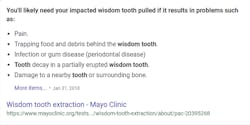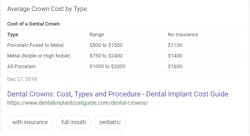How to win a Google answer box and bring in more patients
There is a huge demand for information about dental issues and services on Google. This space is extremely competitive, but there are some steps you can take to position your dental website in order to take advantage of Google’s answer boxes. What are Google answer boxes? These are what are displayed in response to questions that users type in. The purpose of Google’s answer boxes is to provide quick and easy answers, which gives users information before they have to click through to any sites where the information is sourced.
Google added this search engine results page (SERP) feature in 2015, but I’m sure you’ve noticed how much more prevalent answer boxes have become recently. At this time, roughly 15% of queries produce answer boxes that contain information related to the search. These boxes often appear before any other organic result, which can influence traffic more than the number one spot.
My article explains how your content can become featured in answer boxes when someone searches dental questions or services. It can be tricky to navigate your way to these desirable spots if you don’t know how they work.
Types of answer boxes
There are three types of answer boxes—paragraph, list, and table—and different ways to target each. By manipulating some of your content you can find yourself ranking in one of these desirable answer box spots, answering dental-related queries that will drive more traffic and potential patients to your site.
Paragraph boxes
The most common type of answer box is the paragraph style. This box displays a small amount of content that Google feels answers the search question. The purpose of this snippet is to give quick information. If you do a search for something along the lines of, “are veneers permanent?” you’ll get a paragraph-style answer like the one I’ve pictured here from Google. It is important to know that although this site currently ranks third in the regular Google organic listings, it still won the answer box listing. The important thing to note is that you do not need to be ranked first to get your content in the box.
List boxes
Although not nearly as common as paragraph-style boxes, list style is the second most common answer box. These can be numerical or bulleted and are helpful for questions for which the answers are multiple bullets, steps, or directions. A search for “common wisdom teeth removal problems” on Google provides the below list of common issues as the answer. This featured content from the Mayo Clinic is ranked second organically.
The third and least common type of answer box is table style. This type of search result is common when the search is looking for a comparison. It will usually look like a chart to show different variables of whatever is being compared. The image below is the result of the search “types of dental crowns and cost,” with the information coming from the Dental Implant Cost Guide. Here you can see three different types of crowns shown with two pricing elements. This result was ranked fifth in the original organic rankings, but by having the best information for this answer box, it was featured above the other results.
Since this SERP is such a hot spot for search traffic, it is crucial to know all of the elements that go into successfully winning one. There are specific ways to get your dental information featured ahead of the current answer, but you must be strategic in your approach. You will want to make sure that the dental questions you answer are somewhat broad and require a short response, a list, or a table of data to match the answer box types. My suggestions here will give you a good idea of how to get your dental-related content featured ahead of others.
Find common questions doing a keyword research. Before you do anything, you’ll need to do some research to figure out what questions are asked most commonly. If you have a specific topic in mind, you can create a list and run it through a keyword tool such as Keyword Tracker or Ubersuggest. These tools provide estimates on how often those questions are searched each month. If you have a Google AdWords account, you can go right to the source and use Google’s Keyword Planner tool. Our practice site contains an exceptionally helpful database of dental questions with average monthly search volumes. This might be the easiest method for quickly finding popular questions on dental-related topics. Once you have a complete list of questions you’d like to tackle, you can move to the next step.
What dental keywords already produce answer boxes? Although Google is constantly creating new answer boxes, a good place to start is to target keywords that already have an answer box within Google’s results. This allows you to guarantee your efforts will at least have a shot at gaining that spot. You’ll need to go through your initial list of questions and run the searches in Google to refine your list to only those questions that are producing answer boxes. You can expedite this process using a tool that opens searches in bulk, such as searchopener.com.
In many cases, there is a substantial amount of relevant content available for each box, and whoever Google deems to have the best information will be the winner. By reviewing the snippet of information currently displaying in the answer box, you can increase your chances of taking the spot by creating a more accurate and better formulated answer. If you notice any answers that are out of date or inaccurate, you may want to start with these as they’ll be the easiest spots to win if you provide complete, current, and accurate information.
Give Google what it wants. Accuracy is the key. Google wants quality content for search engine optimization (SEO) purposes across all content, and this is no different. As discussed, take the basis of what is currently in the box and improve it. If the current answer is correct but you can make it more correct, Google should recognize that, and this gives you a chance to outrank the current listing.
It can be difficult to ensure accuracy or make an answer more accurate when the question is subjective. For example, “how painful are root canals?” is subjective because it’s different for everyone. But by researching sites that are trusted by Google at the top of the search results, you can figure out what the accurate answer is in Google’s eyes. If the American Dental Association, WebMD, and Colgate say root canals may be painful, you can pretty well assume that Google will agree with you if you say they can be painful. If trusted sites have a consistent consensus on subjective ideas, Google will honor that as an accurate answer.
Another way to increase your chance of winning an answer box is to make sure your answer is clear and concise. You will want to place your answer as close to the top of a paragraph as you can while also creating well-constructed content that someone actually wants to read. Later I’ll discuss how to maximize the length of an answer box for traffic purposes.
Give Google what it wants and how it wants it. An active answer box will give you a good idea of what makes a winner. Seeing how the current answer is formatted will show you how Google wants it, then you can format it better. Do this by adding the exact keywords of the question in the H1 or H2 tags on your page, with the complete and accurate answer immediately after. If Google wants a paragraph answer, your heading should include the exact question keywords, with the bulk of the answer at the beginning of the paragraph. If Google wants a list answer, your heading should contain the question keywords, with the relevant list under that. If Google wants a table answer, make the title of your table the keyword and fill out the rest of the information accurately, adding details where possible. It’s wise to click on the current answer box winner’s site to get a better idea of where and how their content is displayed.
You have a better chance of winning an answer box if the keywords are exact. For example, if you see a dental question box for “are veneers permanent?” you will want your content to say “are veneers permanent?” not “how long lasting are veneers?” Using any form of the keyword other than how it is in the query will decrease your chances of winning a competitive answer box query.
They say if you’re not first you’re last. But this is not the case with answer boxes. Google will pull the most relevant information from any website on the first page. This is a big opportunity because if you are ranked seventh or eighth in the standard listings for the question “how to brush your teeth,” you can still jump to the front of the line. If your answer is the best and is well formatted, you will win the box and featured above your competitors. By getting your information featured in a Google answer box, you will have two listings on one search result page, which will drastically improve your chances of earning that click. So, it doesn’t matter if you’re first or last on the first page, as long as you’re there you have an equal chance at securing the spot.
Encourage traffic by using Google’s maximum length. After you’ve won the dental question answer box by creating the most complete and accurate snippet, you will want to maximize traffic from it. If you do not take advantage of Google’s maximum character length, your information will essentially be exploited by Google, leaving you with answer box bragging rights while likely missing out on the opportunity to maximize your traffic. By providing the full answer in fewer characters than Google’s maximum length, Google will display your entire answer for searchers without forcing them to click on your site, leaving you with limited traffic potential.
A good way to make sure your hard work pays off is to make sure your answers are longer than Google is willing to display. By writing longer answers you encourage users to click on your site for the full answer. For example, in the “are veneers permanent?” search answer box, you can see that although it answers the question at the beginning of the paragraph, it offers the link directly below the answer. This suggests there is more to the answer when it cuts off at “however, irreversible.”
If you have an answer that displays like this, you may want to reword your text so that it’s obvious the answer is more complex. A better example is in the “common wisdom teeth removal problems” list box, where it only shows five out of the seven bullets and offers a link for “more items.” A good rule of thumb for list-style boxes is to have more than five points as Google is unlikely to show more than four or five in a box. Although these are not tips for how to win an answer box listing, they are a good way to ensure that you get the maximum amount of traffic from your listing.
This information should allow you to properly optimize your site’s information to create answer box winning content. While there is no simple way to guarantee you will secure these spots, knowing what it takes to win them will help you create content that gives you a chance to substantially grow your site’s traffic.




